“In a crowd of doddering old men, Dalgoda is a bright, bouncing baby of a comic – thoroughly enjoyable and thoroughly modern.”
– Frank Miller
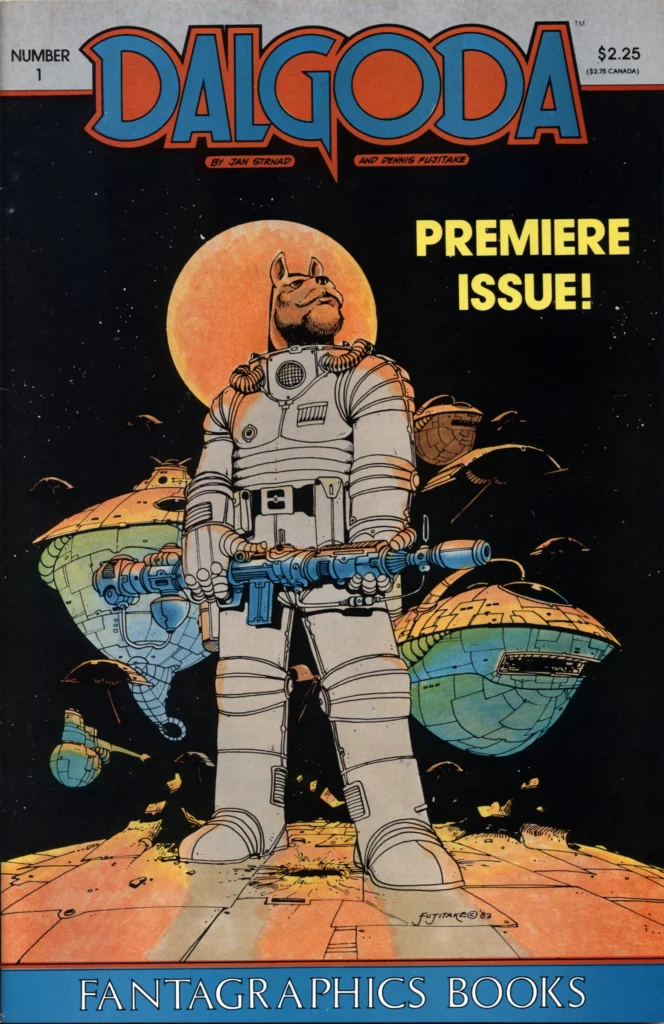
High praise indeed from an acknowledged master of comics who was at the height of his success when this quote appeared in an ad in the May 1986 issue of Amazing Heroes, a magazine for comic book fans and collectors. But chances are, you’ve never even heard of Dalgoda.
This exceedingly charming comic book began publication in 1984. Its publisher, Fantagraphics, was (and still is) primarily known for edgy, critically acclaimed black and white titles like Love and Rockets, Black Hole, Eightball, and The Acme Novelty Library, as well as for high end library collections of classic comics. They also published The Comics Journal, which for many years was the only magazine dedicated to serious discussion and criticism of comics. In the early 1980s they made a stab at doing mainstream color comics, with Dalgoda as their flagship title.
Familiar but different
From the first issue we can see that Dalgoda is going to be somewhat different. We start off with what looks like a standard “alien visits Earth” story as a spacecraft crash lands in what looks like the south Pacific in the 1950s. The craft is fished out of the ocean by a U. S. Navy carrier, with the crew speculating that it might be Russian or Chinese. It all seems very familiar until the captain says “get somebody on deck with spacecraft experience…”
Initial contact with the spacecraft’s occupant has him sitting in shadow, pointing a gun and demanding to see his lawyer.
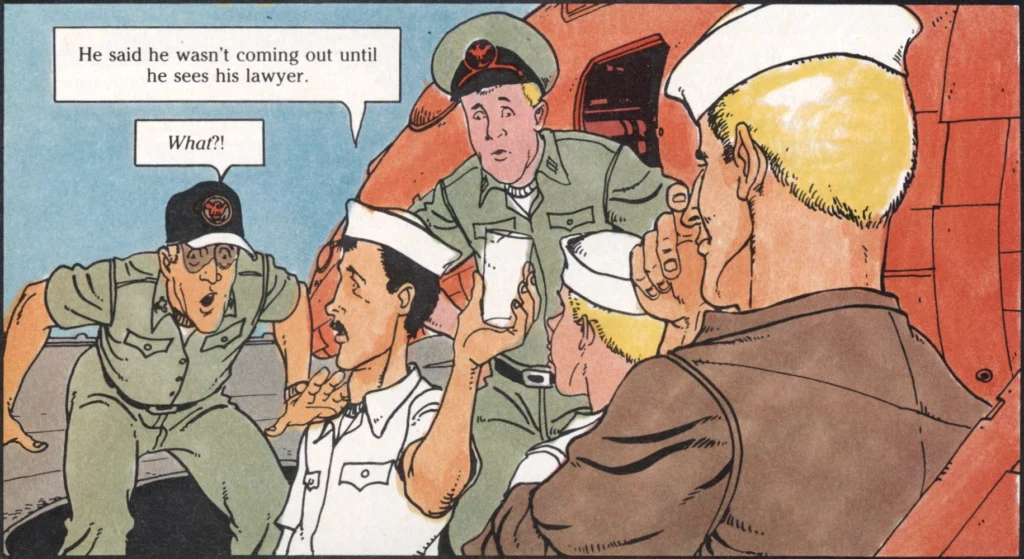
We are shortly introduced to Posey Ravencraft, a disgraced (although we don’t yet know why) naval midshipman and former astronaut who provides a helpful bit of exposition. It is much farther in the future than we have been led to believe, and encounters with the alien, dog-like Canidans, while not common, are at least a known quantity. Diplomatic relations are strained, but improving thanks to the emergence of an unidentified third spacefaring race that seems intent on attack.
Eventually the spacecraft’s occupant is revealed to be Dalgoda, a Canidan sent by his people to ask the Earth for help against the warlike Nimp. His mission is complicated by the long amount of time it has taken to get to Earth. He has brokered a deal with the Earth authorities to trade advanced spaceflight technology for warships to defend against the Nimp, but of course he soon becomes entangled in a swirling mass of government bureaucracy and conspiracy.
Humor, not comedy
The first issue ends with an exciting action sequence as Dalgoda is attacked by an assassin robot. The scene reveals that Dalgoda is an unlikely hero; far from being a highly competent action star, he’s kind of a goof. His flight from the robot finds him tripping over or bumping into everything and everyone in sight and eventually hiding out in a public toilet stall until the robot is taken down by the government agents who have been secretly spying on him.
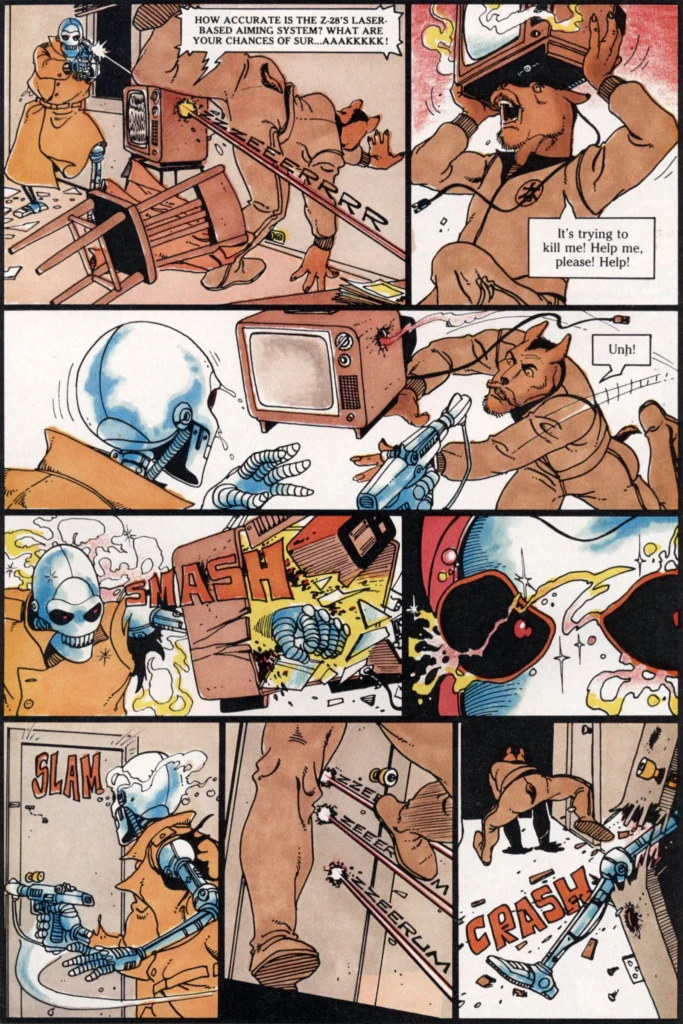
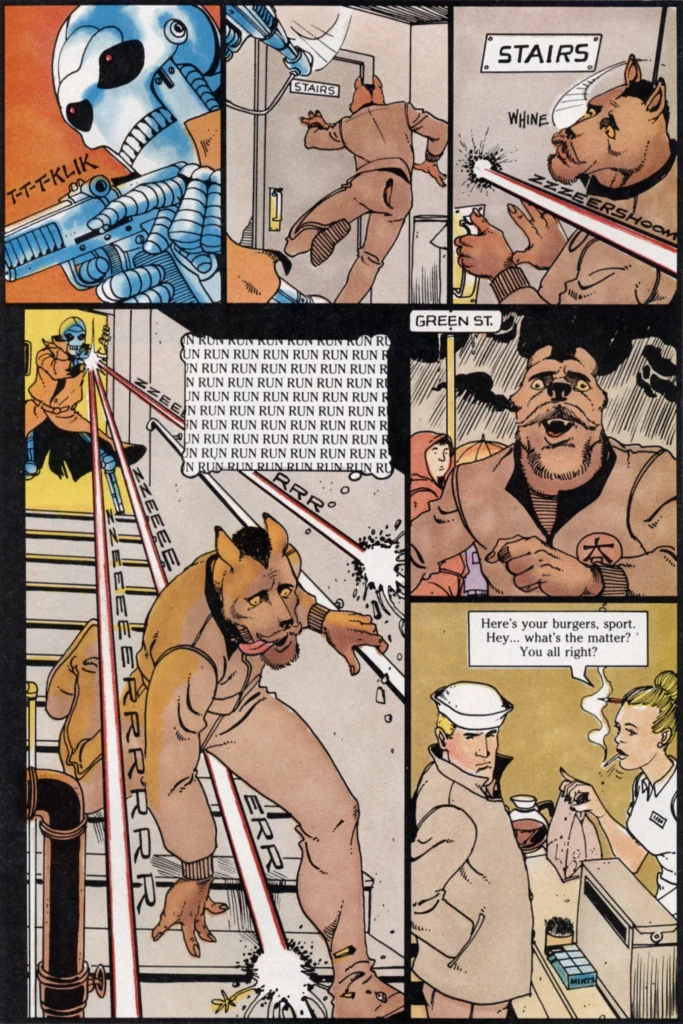
Pages from Dalgoda issue 1. Words by Jan Strnad, artwork by Dennis Fujitake. © 1984 Jan Strnad & Dennis Fujitake.
What follows is a fairly lighthearted series of humorous misadventures as Dalgoda and Posey attempt to navigate a maze of politics and power struggles. Although the stories contain a fair amount of humor, Dalgoda is definitely not a comedy. The humor evolves naturally as we get to know the characters and the often bizarre situations they find themselves in. Illustrator Dennis Fujitake’s style is perfect for the tone of the writing, just exaggerated enough so that the characters are expressive and the movement fluid, but not so much that we can’t take the more dramatic story beats seriously.
Episodes vs story arcs
The second issue settles into what will become the overall structure of the series, and demonstrates a fundamental difference between the way comics were written in the 1980s and the way they are now. In the 1980s, the trade paperback collections that are so ubiquitous today were relatively rare, and at best an afterthought to a comics writer planning the structure of their story. Comics were written with the single issue as the primary means of getting the material out, so stories tended to be fairly self-contained from issue to issue.
Dalgoda is fairly successful at having it both ways. It is clear that there is an overarching story as Dal and Posey work to get their relief fleet up and running, and that story forms a backbone for a series of episodes that stand on their own while also moving the main story forward. Issue two has Dal and Posey inspecting the first ship in their armada and introduces Gunner, Posey’s on again/off again girlfriend and a tough-as-nails mechanic who provides the voice of reason and pragmatism to Posey’s introspection and Dal’s bewilderment. We also meet Victor Kneedam, another disgraced former astronaut who has history with Posey and an undisclosed connection to Dal’s lawyer, Randy Kneedam. With the supporting cast and a few dangling plot threads in place, the issue rounds out with a quick action piece involving Dalgoda being attacked by a killer plant.
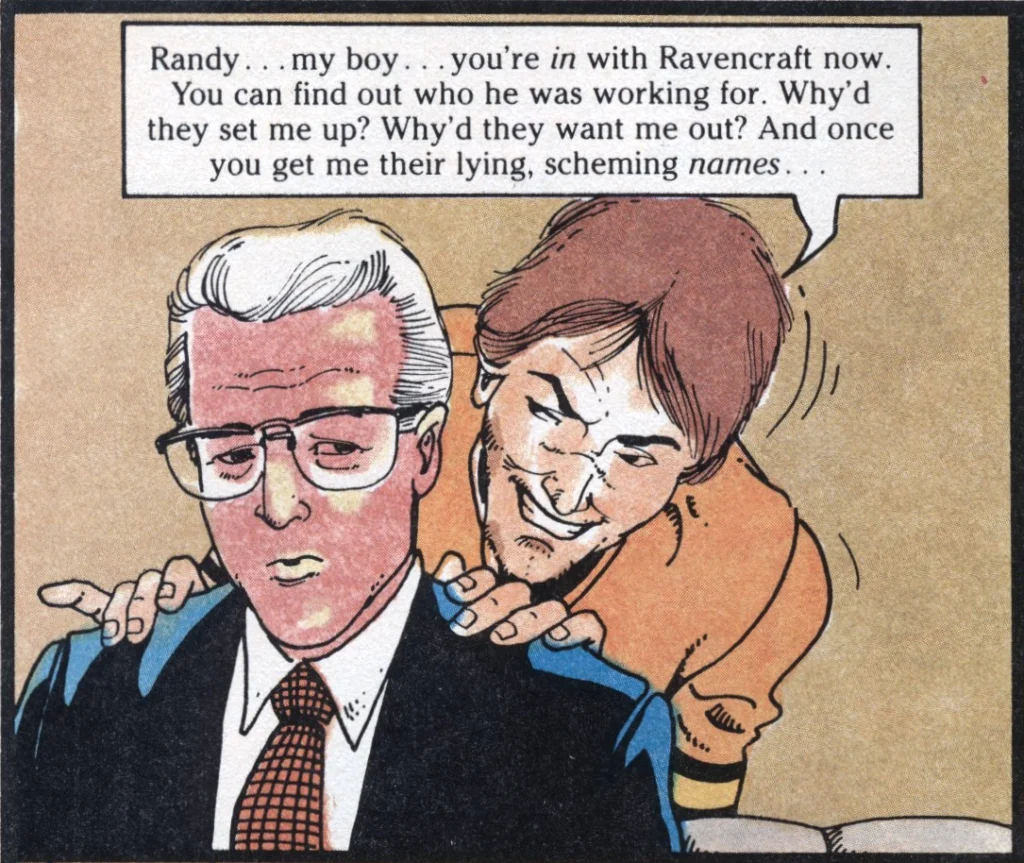
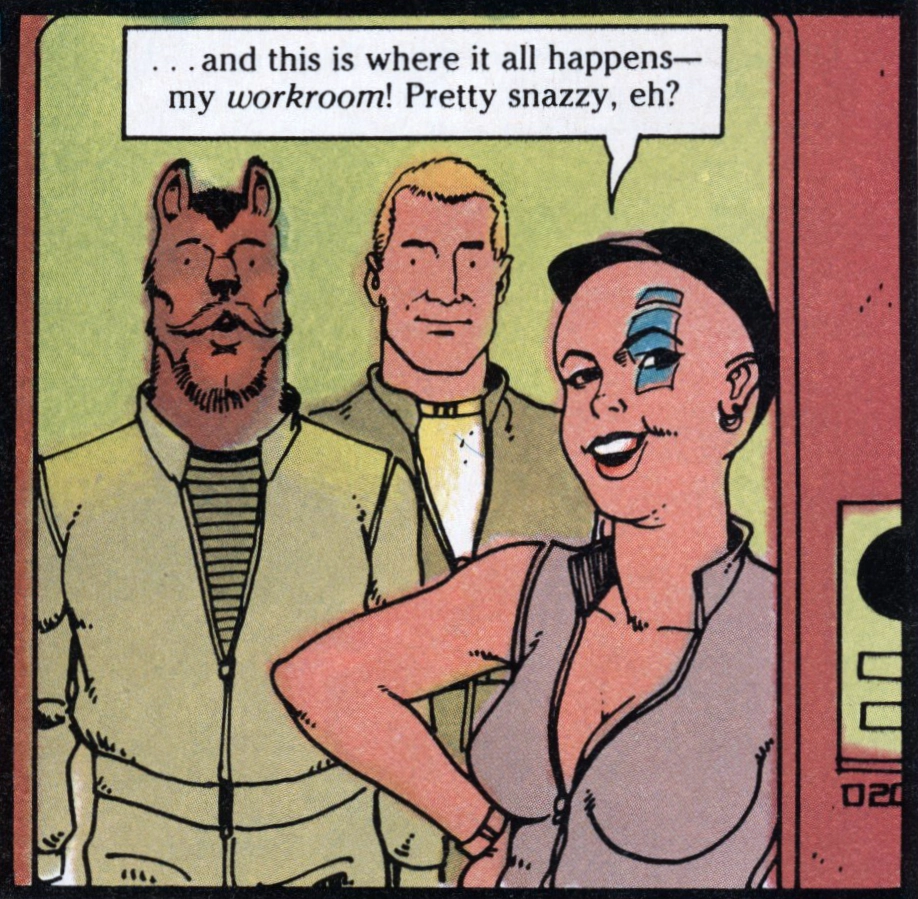
Panels from Dalgoda issue 2. © 1984 Jan Strnad & Dennis Fujitake.
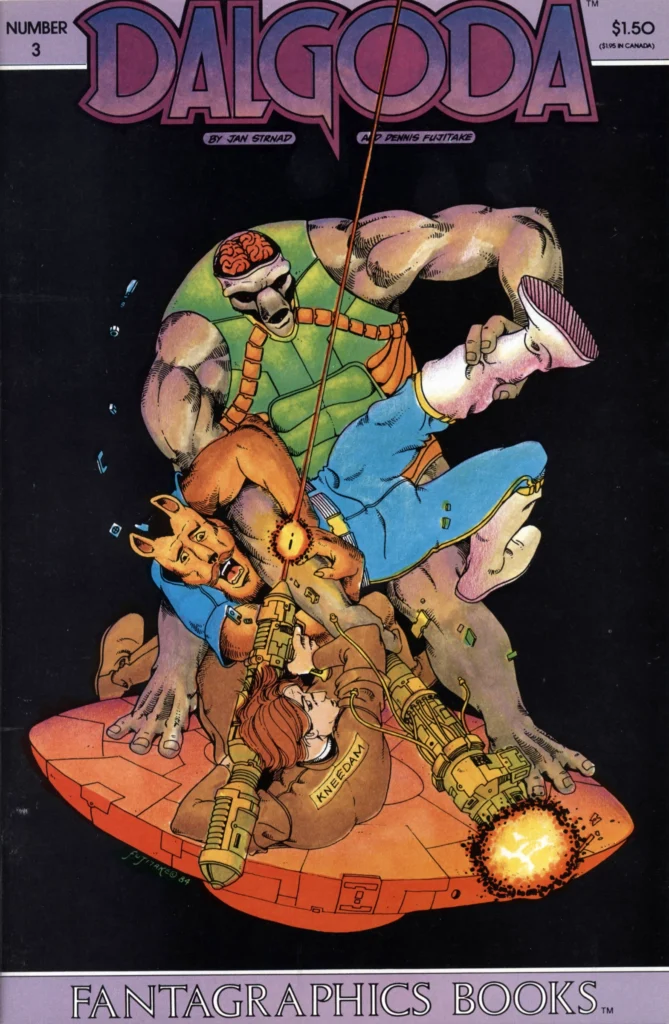
The third issue runs with a fairly run-of-the-mill science fiction plot about robots powered by the brains of dead soldiers being used as cheap labor. It’s a good frame to hang more character development on, as we learn more about Victor Kneedam, the ship’s janitor. He was disgraced after crashing a spacecraft while intoxicated, although he insists he never had a drop of alcohol. We also learn that Posey was the one who got him busted for it. During the course of the action we see Victor suddenly overcome with dizzyness, hinting that there may be more going on than a drinking problem. The story ends with Dal and Victor teleported to an idyllic south Pacific island with what seems like nothing more than a humorous punchline, however…
At the start of issue four, Dal and Victor are still on the island, and have been for a few days. It is occupied by a seemingly friendly tribe of Pacific islanders and appears to be untouched by modern society or technology. It doesn’t seem like they’ve been there for all that long, but as the scene shifts back to the rest of the cast it becomes clear that they’ve been gone for months. The search has been called off, and Posey has been let go from his position as Dalgoda’s liason – a position he was hoping would revive his career as an astronaut. Posey has sunk into drinking and depression, and appears to be contemplating ending it all.
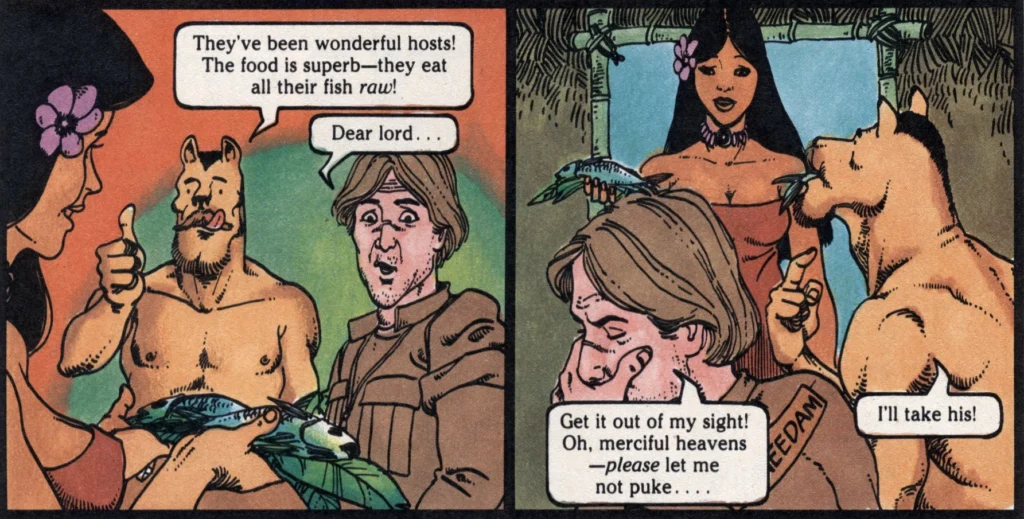
Meanwhile, it is hinted that there might be something sinister going on with the island natives, as one of them lures Dalgoda into the ocean. It turns out that the island was obliterated in a bomb test fifteen years earlier and has been consigned to a Brigadoon-like existence, fading in and out of reality. The friendly native was trying to get Dal and Victor off the island before it disappeared again. After a somewhat improbable rescue by a navy vessel, Dal is able to reach Posey by phone just in time to stop him doing something drastic.
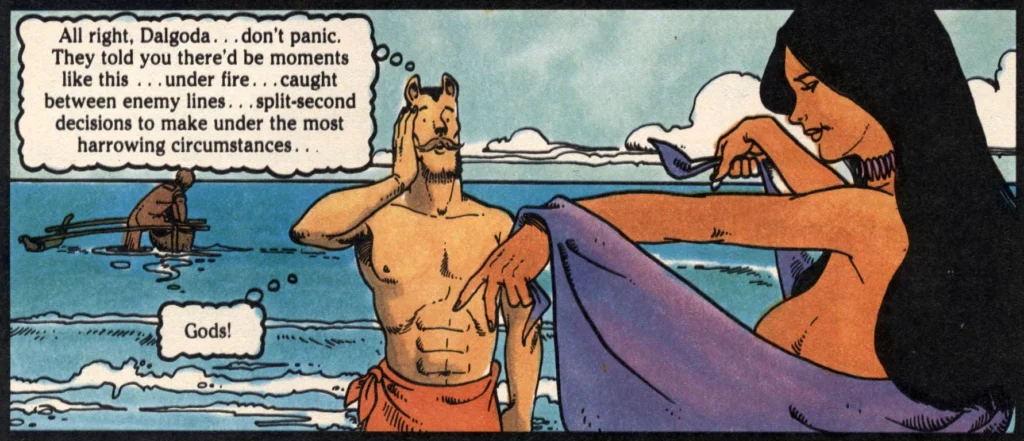
The plot moves forward
Issues five and six form a two-part story that pays off on most of the series’ dangling plot threads, and also sets up the next story arc. Dalgoda has a heart-to-heard conversation with his lawyer, Randy Kneedam, in which it is revealed that Victor is Randy’s father, in spite of looking many years younger. Victor’s former career as a space pilot caused him to spend years in suspended animation, while his son aged normally back on Earth.
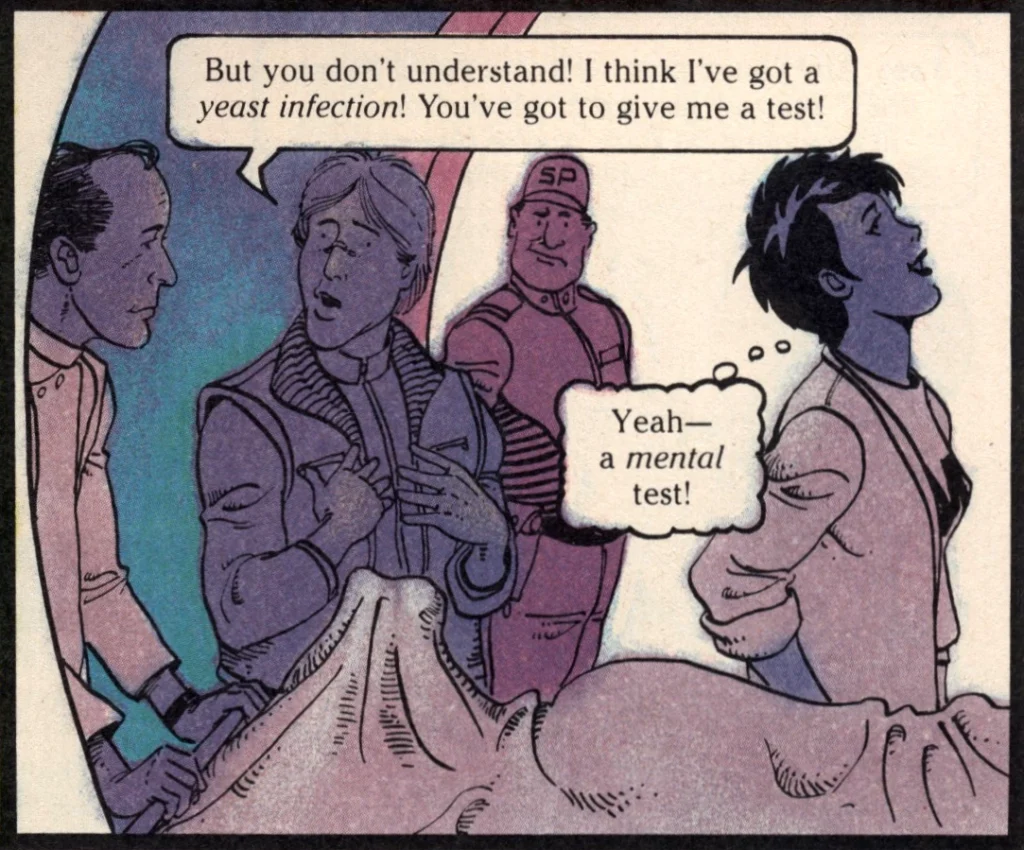
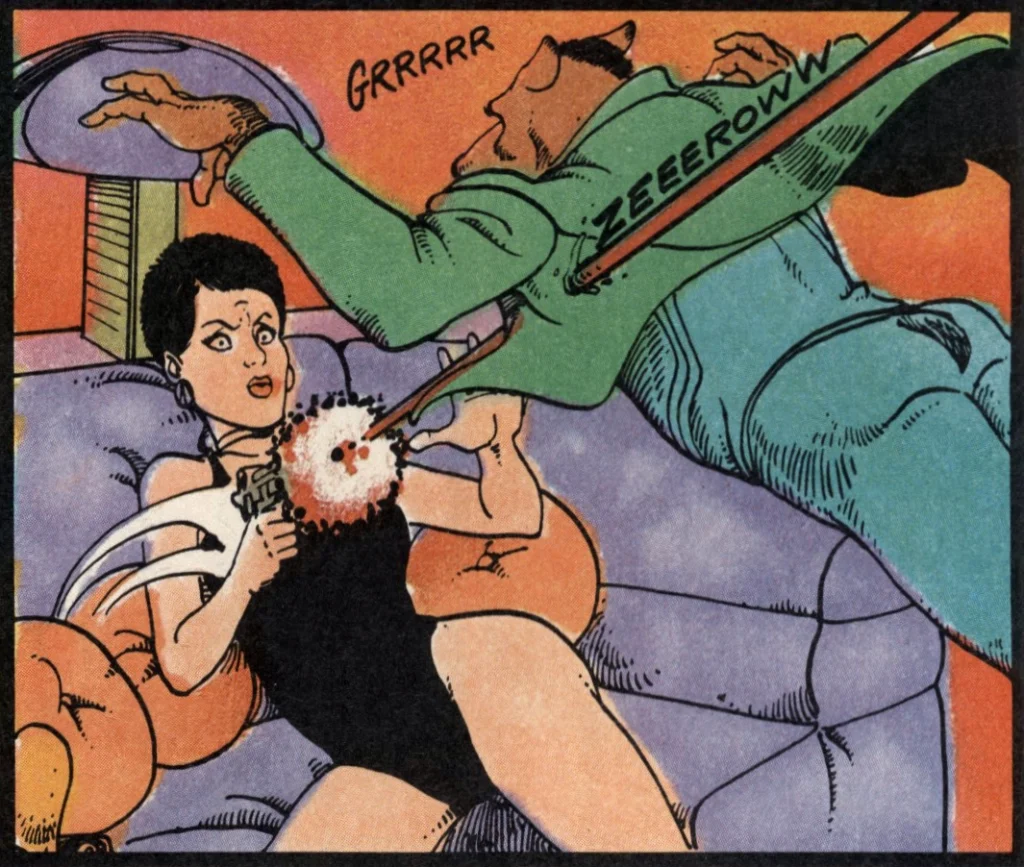
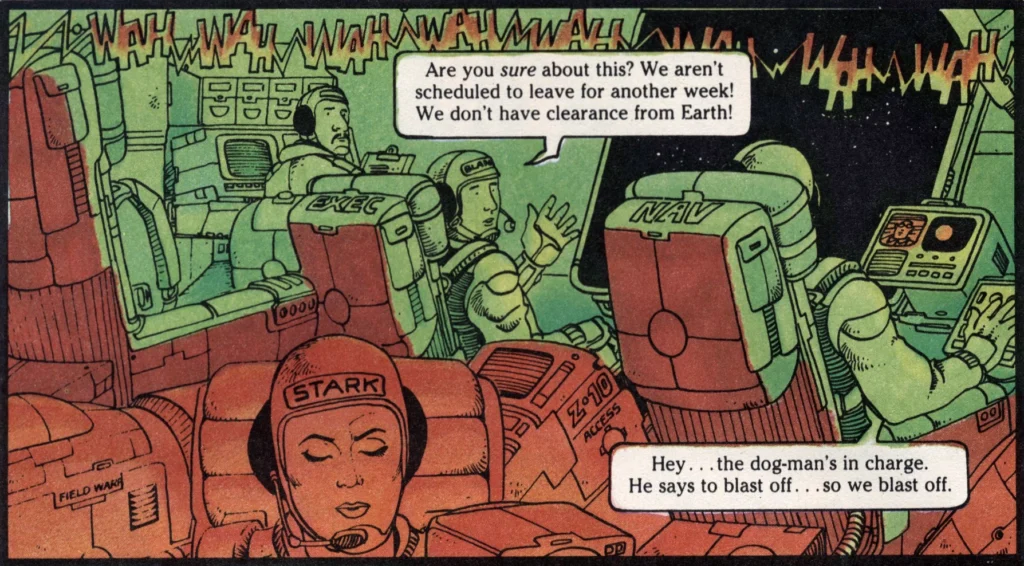
Panels from Dalgoda issue 5. © 1985 Jan Strnad & Dennis Fujitake.
Victor finds evidence that his spontaneous attacks of intoxication might just be due to an exotic fungal infection. We meet Posey’s ex-wife Lenore, who left him years earlier for the only other Canidan currently residing on Earth. Lenore turns out to be a political extremist who kills her Canidan husband and attempts to assassinate Dalgoda, and later reveals that the supposed terrorist group she works for is actually controlled by the world security agency. In a rare moment of self-determinism, Dalgoda hijacks the three space ships that have been fitted with Canidan technology allowing them to move faster than light. He finally makes it back home to Canida, only to find that it is surrounded by a fleet of hostile Nimp ships, the planet is in ruins, and the population have teleported away to an undisclosed location.
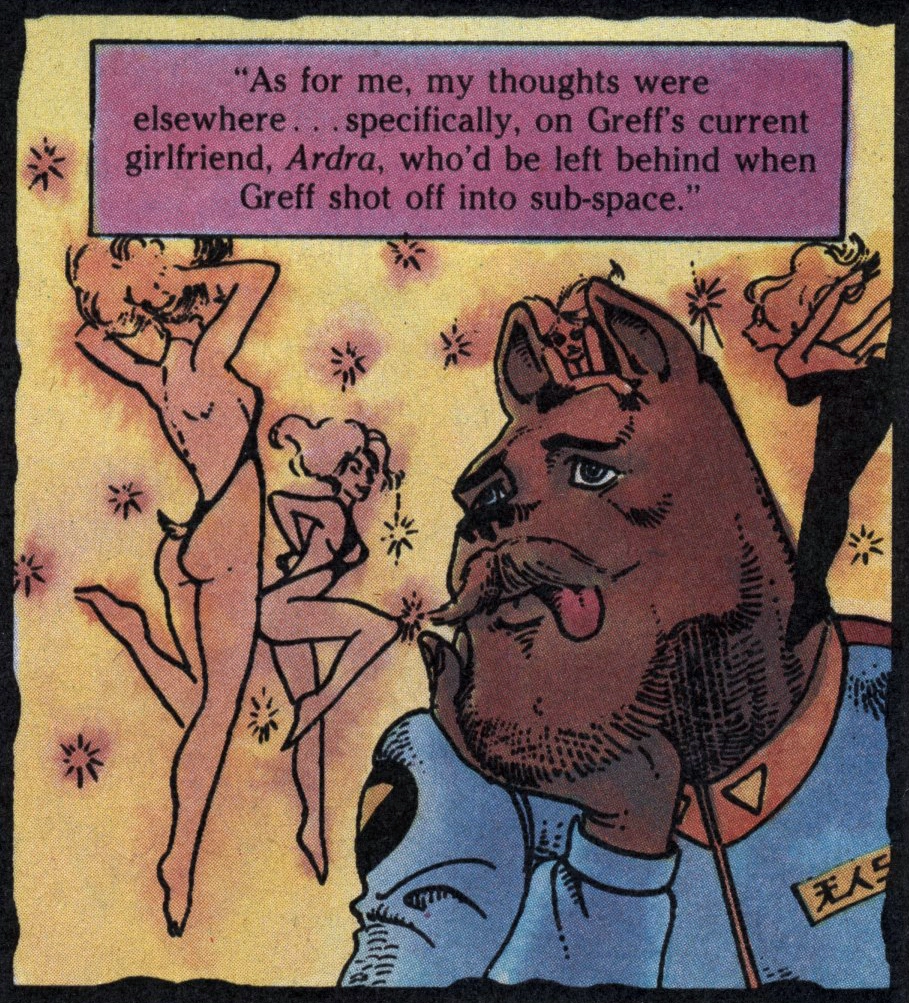
Issue 7 provides some backstory on our title character. Apparently he was a bit of a screw-up who got the mission to come to Earth by accident. In the present, Dalgoda has been accepted as captain by the crew of the hijacked fleet, but it becomes clear that faster-than-light travel is causing the fleet’s crew to experience horrific hallucinations. Dal winds up in a straight jacket, giving his detractors in the fleet an opportunity to attempt a mutiny. To make matters worse, we find that Lenore was still on the ship when it jumped away from Earth, and she makes a suicidal attempt at sabotage.
The story stays interesting by juggling multiple plot threads (Dalgoda’s backstory, Victor’s sudden bouts of intoxication), punctuated by the occasional burst of relentless action.
The end…or is it?
Issue eight, published in April 1986, was the final issue of the series. It wraps up the mutiny storyline with the death of a major character, but a few plot threads are left unresolved. Most importantly, we never learn the final fate of Dalgoda’s people, including Chim, a new supporting character and love interest introduced in the previous issue’s flashback. The issue ends on a bittersweet note.
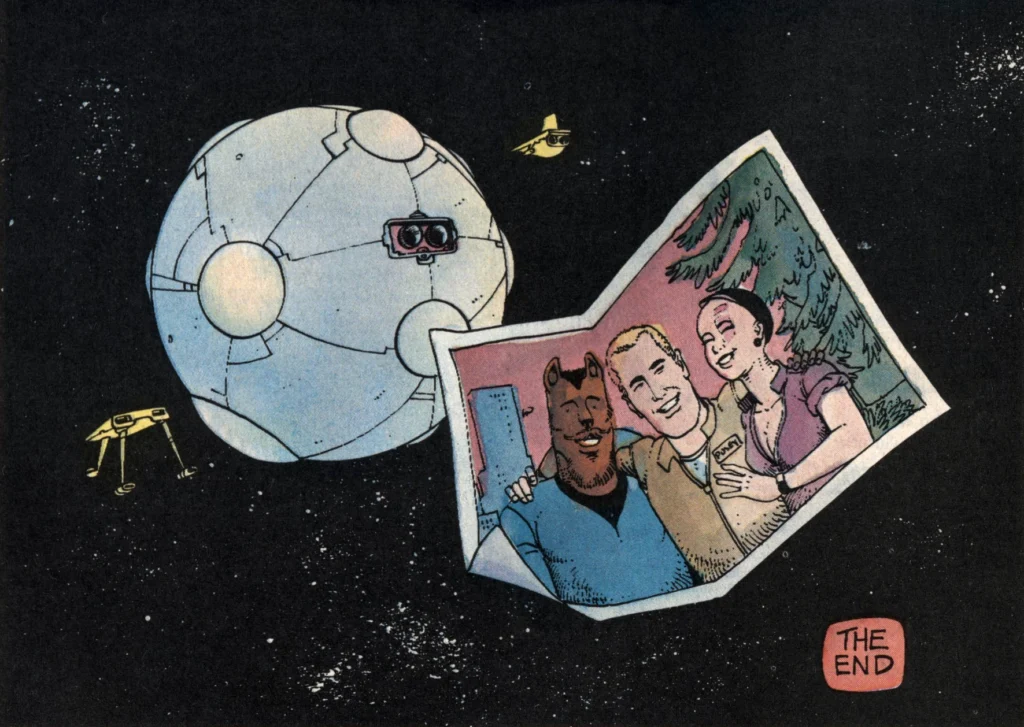
However, an advertisement on the back cover (and also the issue’s text introduction) promises more to come in the form of Flesh & Bones, a four issue miniseries “coming this summer.” Apparently the primary reason for the cancellation and restart of the series had to do with the formation of Upshot Graphics, a new publishing imprint that would allow Fantagraphics to more effectively market their mainstream, action-adventure color titles separately from their more highbrow black and white fare.
A new (but short-lived) beginning
Throughout it’s publishing life, Dalgoda’s creative team struggled with getting the book out on time. Ostensibly a bi-monthly comic book, they only managed to publish eight issues between August 1984 and April 1986. In a text piece in issue three, Dalgoda writer Jan Strnad explained that this wasn’t due to the creators running behind, but rather the process by which a small publisher like Fantagraphics got a full color comic book printed. Due to the relatively small quantity of books they were printing, they had to batch print their book with color books from other small publishers. One of those publishers was Pacific Comics, whose bankruptcy in 1984 meant that there were fewer color books to batch print with, causing delays.
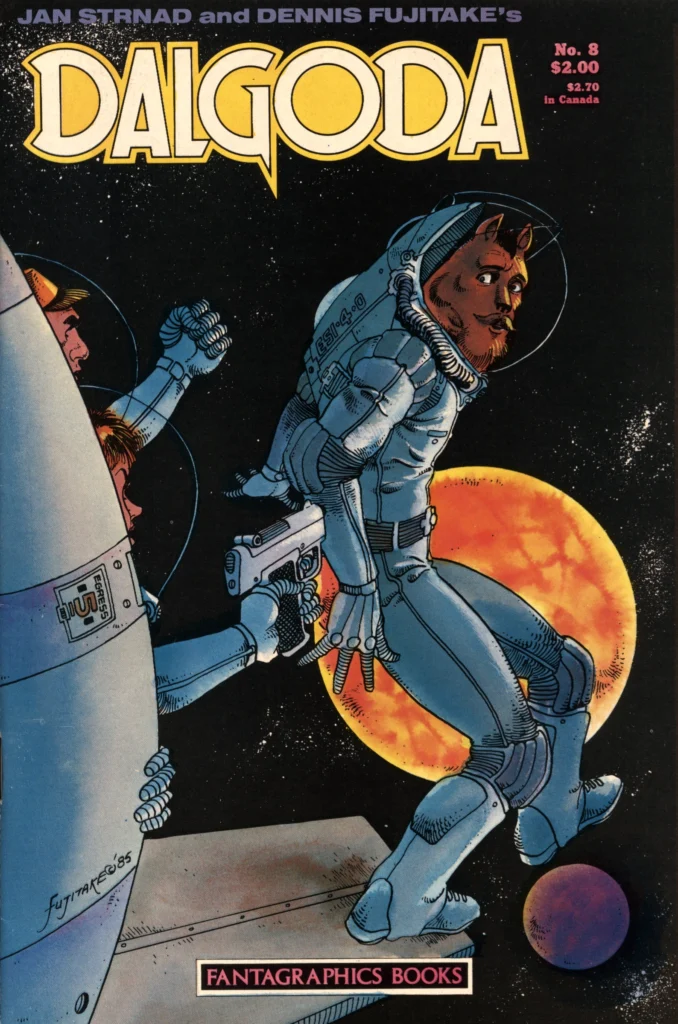
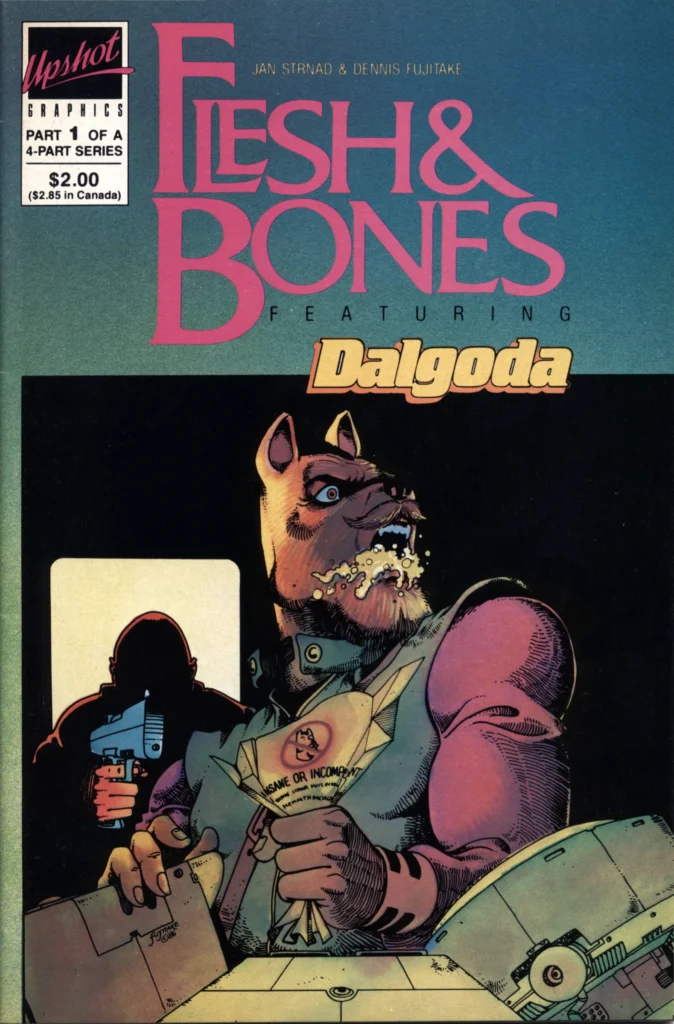

Strnad’s answer to this seems obvious: publish more color comics! But color was expensive to produce and print, so any additional color books would need to try for more mass appeal than the average Fantagraphics title. So Strnad convinced Fantagraphics to form a separate imprint to market a line of color action-adventure themed titles. The decision was made to run the new titles in four issue blocks rather than as ongoing series, which would allow them to be scheduled more efficiently. The first of these was Flesh & Bones, a four issue miniseries that continued Dalgoda’s story.
Right where we left off
Flesh & Bones issue one begins in media res during the mutiny from Dalgoda issues seven and eight. The action is described from the point of view of navigator Stark, previously just a background character but now a main focus of the story. Stark reveals that the attempted mutiny isn’t over yet. She goes on to describe how Dal regains power over the fleet by issuing seemingly nonsensical orders, moving supplies around and reassigning crew between the ships. It turns out that Dal’s plan all along is to take one ship and separate it from the fleet. This will allow him to leave the mutineers and the majority of the crew and civilians to return to Earth while he and his loyal friends continue their search for the planet Demmeon, where he hopes to find the rest of his people.
In issue two we learn that Stark is experiencing waking hallucinations in the form of “angels,” revealing that she comes from a highly religious background. It is hinted that she has a history of sexual abuse, but this is handled very subtly and largely left to the reader to interpret. Additionally, Stark in having somewhat erotic dreams about Dalgoda, who she clearly has a crush on, but which also have an undeniably religious content.
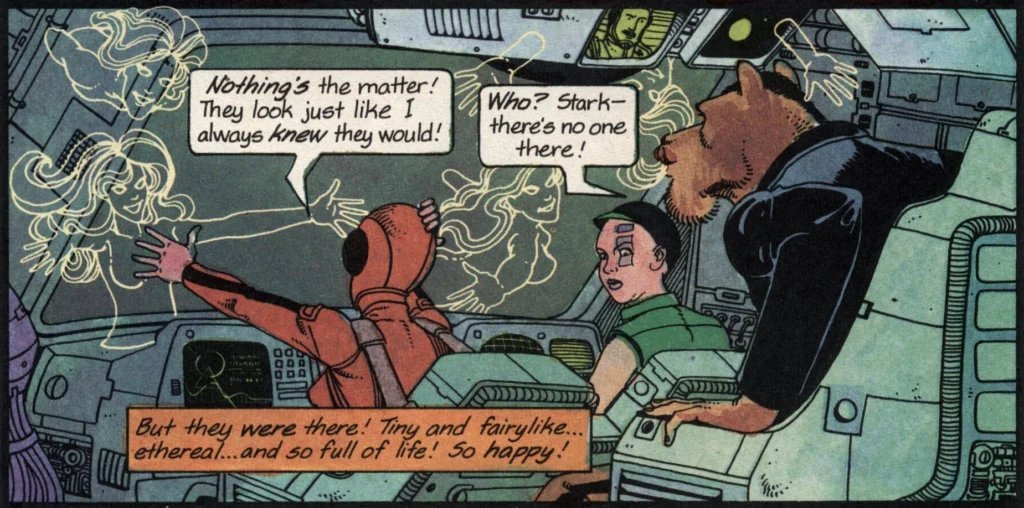
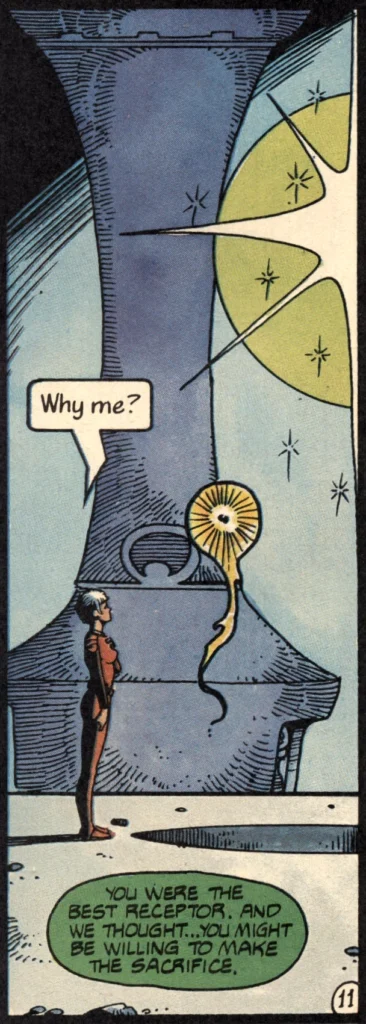
Dal and his crew soon arrive at Demmeon, where they are forced to use an experimental weapon to evade a trio of Nimp warships. During the action it becomes clear that Stark’s “angels” are speaking to her and appear to have an agenda of their own. Meanwhile, Dal receives proof that there are Canidans on the planet below.
Issue three finds the crew exploring the ruins on Demmeon, where Stark discovers that her “angels” are part of a race of post-physical, pure energy beings who have previously contacted Dalgoda’s people (way back in Dalgoda #1). They are also under threat from the Nimp, and they need Stark’s help. In order do do what must be done, Stark will need to give up her physical body and become a being of pure energy. After some soul-searching she finds she’s okay with this.
Everything comes to a head in issue 4. Dal and crew evade a Nimp attack with the help of a team of Canidans which includes Dal’s former (and likely future) love interest Chim. The issue is all action, with flying motorcycle chases, betrayals, a giant mechanical bug, and a thrilling last-minute escape and reunion with his people for Dalgoda. In a charming epilogue, we find that Gunner and the rest of Dal’s human crew are on their way home, Stark is happy living among the post-physical Demmeonites, and Dal and Chim live happily ever after.
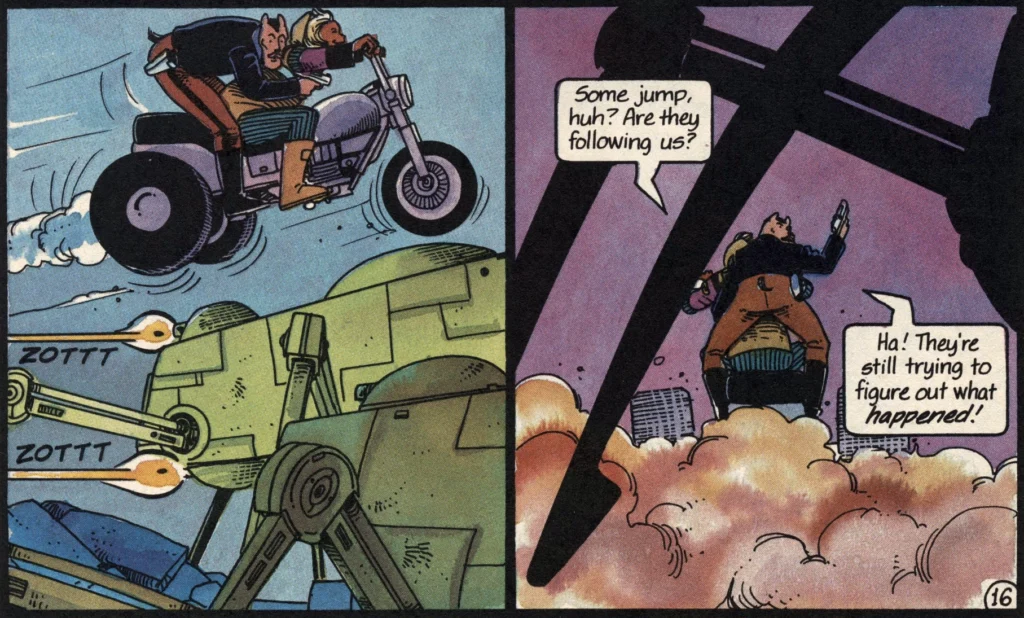
Where are they now?
Jan Strnad’s rather forward-thinking plan for Upshot Graphics was that they would publish everything as four-issue miniseries, making it easy to do trade paperback collections and keep the work in print (something that almost every publisher does now). Unfortunately, Upshot was rather short-lived, only publishing two other titles before fading away. For reasons unknown, to this day Dalgoda and Flesh & Bones have never been reprinted or collected.
Writer Jan Strnad went on to form Mad Dog Graphics, another short lived publishing concern where he did Keith Laumer’s Retief with Dalgoda artist Dennis Fujitake, a black and white series adapting Laumer’s short stories. Fujitake’s name pops up here and there, but the only other substantial series he appears to have worked on is Return to Centaur, a black and white adaptation of Piers Anthony’s novel Isle of View. Strnad moved into writing for animation, but kept his hand in comics as well, writing for, among other things, Marvel’s Clive Barker’s Hellraiser and Dark Horse’s Star Wars comics.
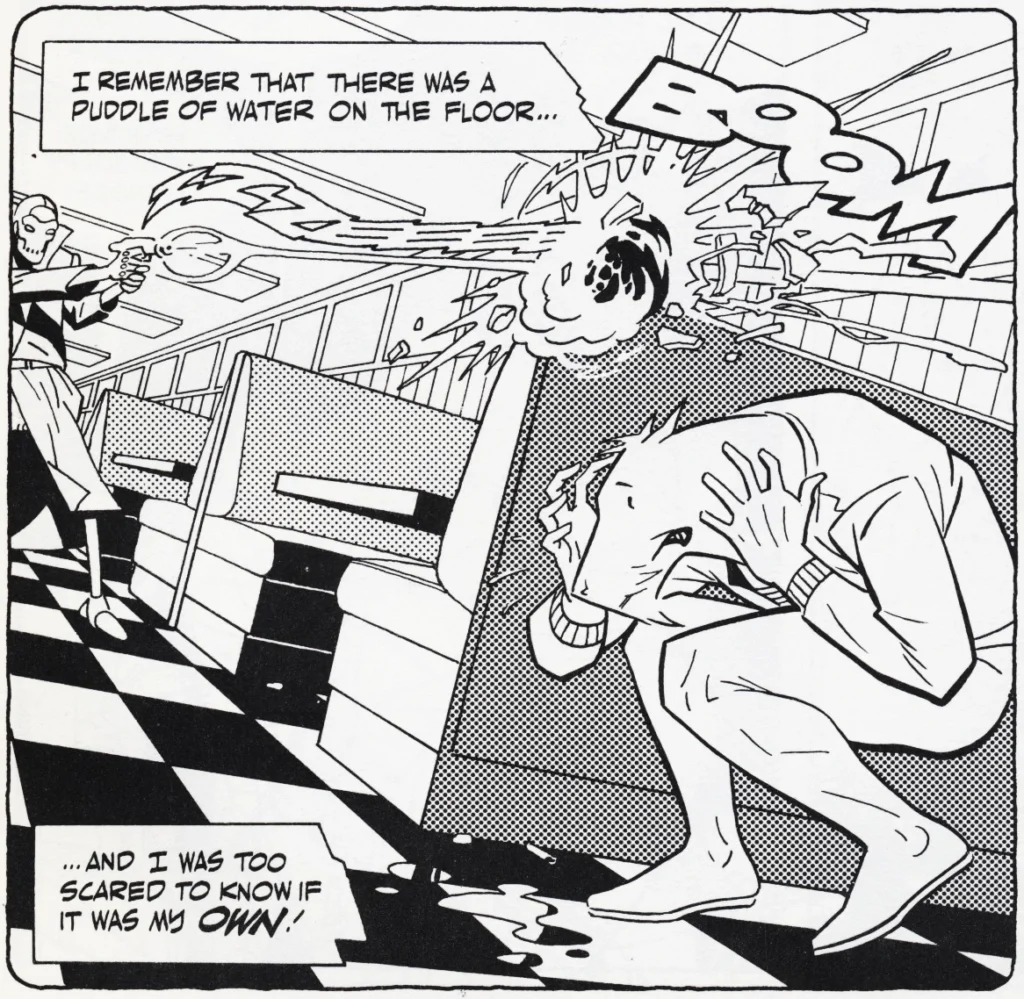
There was one final Dalgoda tale, published in the fourth volume of A1, a prestigious British anthology series. The black and white story features Dalgoda grappling with his status as a hero to his people as he is called upon to play himself in a movie. The gentle humor is a welcome return to form after the somewhat more serious tone of Flesh & Bones, but the artwork by Kevin Nowlan is quite a departure from the consistent look Dennis Fujitake gave the rest of the series.
UPDATE: As of February 2025, Dalgoda is back in print thanks to the fine folks at About Comics. Their new black & white omnibus edition includes the original eight issues, the complete Flesh & Bones miniseries, the story from A1, and “Pupsicle,” a short story I didn’t even know existed that originally published in Doomsday Squad #1 in 1986. More information can be found on the About Comics website.
